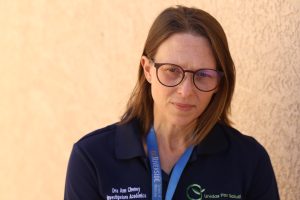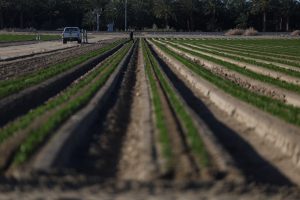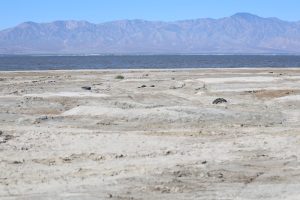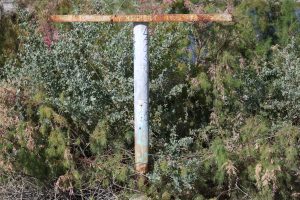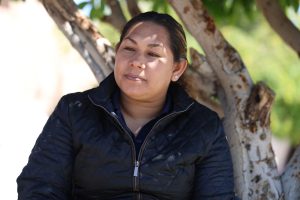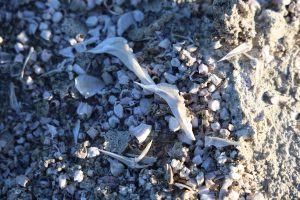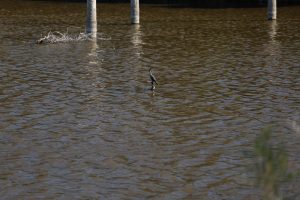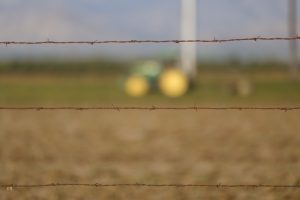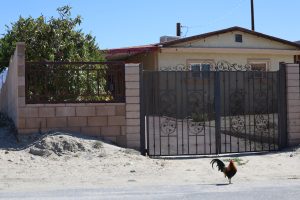- Slug: BC-CNS-Salton Sea. 775 words.
- 17 photos available (thumbnails, captions below).
By Jack Orleans
Cronkite News
NORTH SHORE, California – As it deteriorates, the ecosystem around the Salton Sea in Riverside County in Southern California, has been creating a toxic environment that hurts the health of children of immigrant families who live and work there, according to researchers.
A 2023 study by the University of California, Riverside, looked at the immigrant population of low-income Hispanic and Indigenous Mexican Hispanic people in communities around the Salton Sea and found that the rate of childhood asthma is 20% to 22.4%, much higher than the California average of 14.5%. The study’s researchers said that the health problems are caused by the dust from the remains of fish that ingested toxic materials from the water in the Salton Sea.
“When I moved to North Shore, I started having problems with one of my children because at a young age, 2 months old, he started having breathing problems,” said Solangel Cruz, a resident of North Shore, California, who works in the agriculture fields. “He got the flu and from the flu he got bronchitis.”
The UC Riverside study showed that when dust from the dried-up seabed is blown by the wind and inhaled, it activates immune responses in nearby residents.
“One of the concerns that the community faces around the lagoon is allergies, asthma, respiratory problems, eye problems and nosebleeds,” said María Pozar, an area resident who goes by Conchita and was one of the lead researchers of the UC Riverside study.
The Salton Sea, California’s largest lake, is drying at a rate of 1.3 million acre feet per year. A study from the University of California, Agriculture and Natural Resources tracked the deterioration of the sea and surrounding ecosystem and determined that in addition to evaporation, a lot of water has been diverted to urban areas since 2018. Because of that, the salinity of the water and toxic materials in it have been concentrated in the dust, making it dangerous.
“Waste from the water, toxic water, entered here,” Pozar said.
The Salton Sea formed in 1905 when the Colorado River, itself a river with high salinity, burst an irrigation canal gate and flooded the area; the lagoon almost had the same salinity as the ocean. It was an important site for fish that tolerate high salinity and it was also an important feeding ground for birds.
In the 1950s, the Salton Sea was a tourist destination with seaside resorts, marinas and yacht clubs, and it drew both vacationers and entertainers and celebrities. However, there were environmental concerns by the end of the 1960s.
In the 1970s, tropical storms and floods damaged tourist areas. In addition, the salt from nearby agricultural sites mixed with irrigation water from the Colorado River. The lagoon started receding as it dried. The fish that the birds depended on either died from increasing salinity or predation from tilapia, according to the University of California, Agriculture and Natural Resources. In the end, only tilapia remained. Today, the dust comes from the dried seabed which includes decimated fish remains.
According to Pozar, other problems include illegal dumping and a lack of trees and plants that could help trap the dust before it reaches the community.
The respiratory problems persist, but the immigrant community lacks access to health services that could help.
“It’s a very large immigrant population, their familiarity with health care systems is usually the Mexican health care system, which is a very different way about accessing health care,” said Ann Cheney, lead researcher of the UC Riverside study, and a medical anthropologist in the Department of Social Medicine, Population and Public Health at the University of California, Riverside.
Cheney also said that sometimes parents prefer to take their children to Mexico for treatment, if they can cross the border, instead of to doctors in the U.S. Undocumented people aren’t eligible for Medicaid, the Affordable Care Act’s health insurance marketplace or other forms of public health insurance, according to the Substance Abuse and Mental Health Services Administration.
In addition, 30% of farm workers live below the federal poverty line, and 65% lack health insurance, according to the Center for Budget and Policy Priorities.
“There’s a fear that providers are going to ask for a form of identification or are going to ask for insurance coverage,” Cheney said.
Cheney and Pozar said that the mission of the Coachella Valley Free Clinic, operated by the university and led by Pozar, is to go into the immigrant community and provide treatment for the people who need it.
“As a mother, I give myself the obligation to be able to advocate, to be able to do the research that can lead them to a good place,” Pozar said.
For more stories from Cronkite News, visit cronkitenews.azpbs.org.
